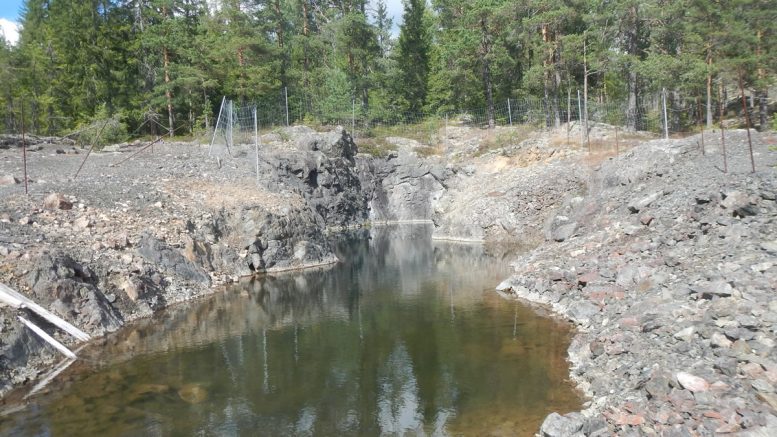Just a few months after finishing a nine-hole, 1,600-metre drill program at its Gumsberg zinc-silver-lead project in Sweden, Boreal Metals (TSXV: BMX) has begun drilling the project again.
The campaign, which began in March, will see Boreal drill another 1,500 metres at the volcanogenic massive sulphide project (VMS) to test a variety of shallow targets. Though the company has eight base and precious metal projects across Europe, it says it finds this one the most compelling.
“It’s partly because right now there’s not a lot of attention being paid to mining stocks,” company chairman Patricio Varas says during an interview with The Northern Miner. “We want to make sure that what we’re drilling is something that we may be able to be put into production without hundreds of millions of tonnes, like you would with some of the copper projects.
“You want something that has a lower capex and high grade, because commodity prices have a lot of fluctuation. I think if you have high grade it insulates you from that up and down that you get from the fluctuation in base metal prices.”
The company has a number of targets at Gumsberg, but is focusing on two right now: Ostra Silvberg and Valletberget-Loberget.
Precious and base metals were mined at Gumsberg at over 30 mines from the 13th century to the early 19th century. Between 1250 and 1590, Ostra Silvberg was the largest silver mine in Sweden. Past operators mined it to 250 metres below surface — “quite extensive for its time,” according to Varas.
When Boreal first drilled Ostra Silvberg in late 2017, it had intended to search for depth extensions of the previously mined mineralization.
“Before we hit it, we hit another deposit that we can’t see at surface, but that we have now hit in six or seven holes,” Varas says. “Ideally we want to expand that, see how big it is. It certainly has fantastic grades.”

Boreal Metals’ Burfjord copper project in northern Norway. Credit: Boreal Metals.
Boreal had found the South zone, lying as much as 50 metres south of the old underground mine. Its first-ever hole hit 16.97% zinc, 656.7 grams silver per tonne, 8.52% lead and 0.76 gram gold per tonne over 11 metres from 122 metres downhole.
“That to me is pretty attractive, and we want to make sure that we follow it up and see if it has any size,” Varas says.
More recent results from the South Zone include 6.73% zinc, 18.53 grams silver and 1.99% lead over 13 metres from 210 metres downhole, as well as 8.75% zinc, 289.32 grams silver, 4.61% lead and 1.08 grams gold over 6 metres from 190 metres downhole. The company intends to continue testing for depth extensions at Ostra Silvberg with its round of drilling.
Boreal also plans to test for extensions along strike at Valletberget, where past drilling by the company cut 5.19% zinc, 16.39 grams silver and 1.08% lead over 7 metres from 99 metres downhole, as well as 13.55% zinc, 51.75 grams silver and 5.23% lead over 2 metres from 92 metres downhole.
“With VMS deposits, they’re not usually very large deposits,” Varas says. “But it’s a VMS area, so you’re going to have multiple deposits.”

Boreal Metals’ historic Gumsberg zinc-silver-lead project near Stockholm, Sweden. Credit: Boreal Metals.
Gumsberg is a two-hour drive, mostly on highway, from Stockholm, Sweden. It has water and power to site and sits in an established mining district — 30 km away from Boliden’s Garpenberg polymetallic mine.
At the end of 2018, Garpenberg contained 22.8 million proven tonnes at 101 grams silver, 3.6% zinc, 1.4% lead and 0.24 gram gold. It also had 53.5 million probable tonnes at 94 grams silver, 2.9% zinc, 1.4% lead and 0.32 gram gold.
“There may be some synergies there in the future,” Varas says.
The company also recently drilled 950 metres across seven holes at its Burfjord iron oxide copper-gold project in northern Norway. Its best hole cut 0.56% copper and 0.26 gram gold over 32 metres from 184 metres downhole, including 4.31% copper and 2.22 grams gold over 3 metres.
Burfjord was mined periodically over the past couple hundred years, and the property features a lot of open pits and shallow underground mines.
“They were basically high-grading copper,” Varas says. “They used to trek high-grade copper ores across the mountains and over to the smelter.”
He says that although past producers mined high-grade copper veins at Burfjord, Boreal realized that the mineralization was widespread, held in broad halos of alteration. The company performed magnetics before drill testing zones near some of the old workings. It hit a couple broad intercepts of mineralization.
“It really confirmed what we thought was most likely there,” Varas says. “There’s definitely a broad zone of mineralization under one of the workings in the south of the project.”
Shares of Boreal Metals are trading at 9¢ in a 52-week range of 4¢ to 24¢. The company has a $6-million market capitalization.
“Ideally, we’d love to raise a bunch of money and go and test the different targets, because I really believe that they all have quite a bit of merit,” Varas says.
“We also maybe need to bring these projects forward by looking for joint ventures or other partnerships, because of course you don’t want to go out there and raise money when your stock is depressed to this extent.”


Be the first to comment on "Boreal pursues new VMS zone at Gumsberg in Sweden"